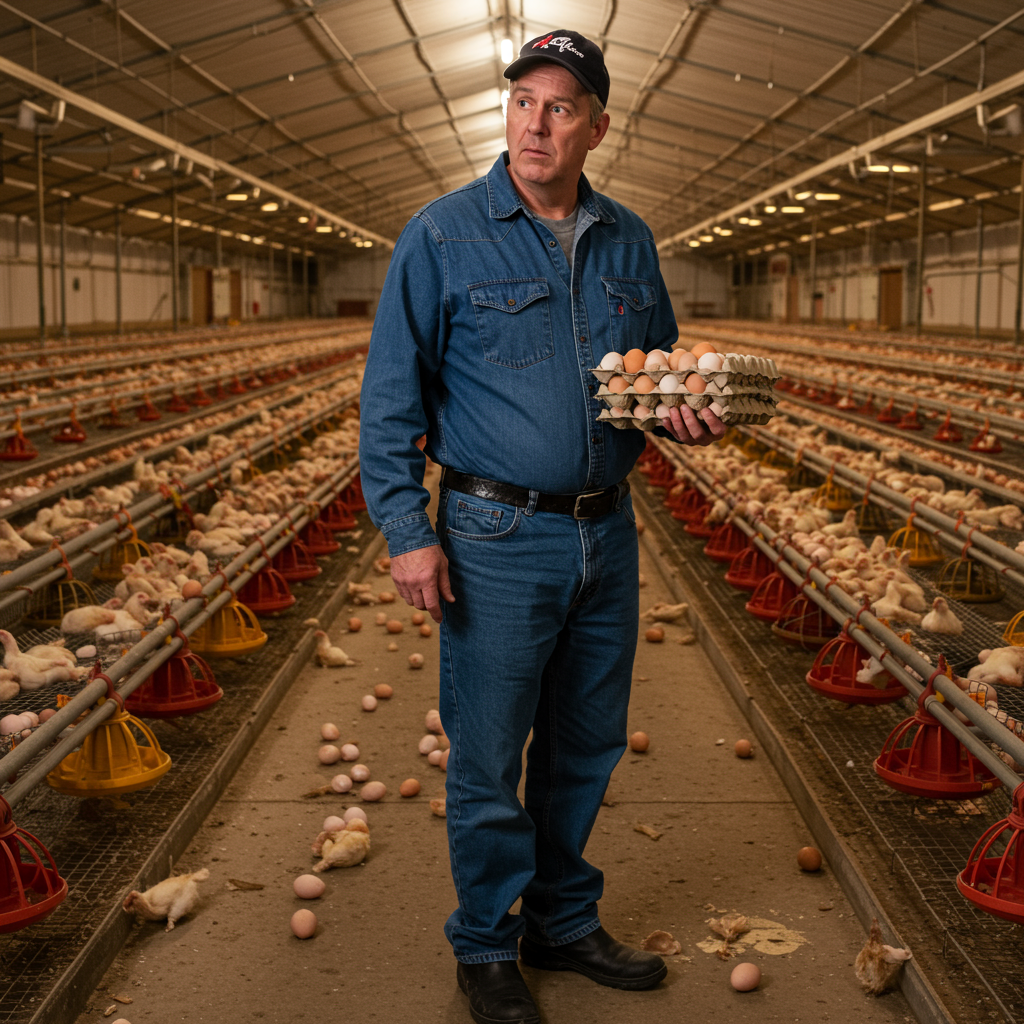The unsettling sense of déjà vu surrounding sky-high egg prices and widespread bird flu outbreaks is more than just a feeling; it’s a recurring, intensifying crisis impacting American consumers and the poultry industry alike. As fall 2025 brought another significant surge in highly pathogenic H5N1 avian influenza, millions of birds have been culled, raising serious concerns about food security, economic stability, and public health. This complex challenge suggests that both bird flu and its ripple effects on egg prices may remain stubbornly difficult to control without a shift in strategy.
This autumn, US poultry operations are once again grappling with a severe wave of bird flu. Since early September 2025, the virus has led to the culling of 7.3 million birds from nearly 50 commercial poultry farms. A staggering three-quarters of these were egg-laying hens, primarily from just three large factory farms. This figure is notably higher than outbreaks during the same period in previous years, signaling a more aggressive and widespread challenge. While these losses currently represent less than two percent of the US egg-laying hen population, preventing an immediate, dramatic impact on prices, experts like Krysten Schuler of Cornell University warn that the early surge, numerous farm outbreaks, and a dominant new variant do not “bode well for a quiet year” for the virus.
The Persistent Threat of H5N1: An Unprecedented Animal Health Crisis
The current H5N1 outbreak is part of a larger, unrelenting pattern that began in early 2022. Since then, over 180 million birds have been killed in the US alone. This strain of avian influenza is particularly virulent, spreading rapidly and devastating flocks. Unlike previous outbreaks that were more seasonal, the current iteration is persistent and ubiquitous, affecting poultry for a third consecutive year. Brian Moscogiuri, a global trade strategist at Eggs Unlimited, described the situation as “as bad as it has ever been” and “uncharted territory,” with the industry losing 26 million birds since October of the current year, impacting over seven percent of the total flock. Maurice Pitesky, a professor at UC Davis, has called it the “largest animal epizootic” ever recorded, noting its pervasive presence even in dairy lagoons and human wastewater.
Chickens are now contracting the flu from a broader array of sources than just migratory waterfowl. The virus can spread from sick dairy cows through shared equipment or via airborne transmission from nearby infected farms. While US egg farms implement stringent biosecurity measures, Emily Metz, President and CEO of the American Egg Board, concedes they are “not foolproof.” Federal policy dictates that once a single bird tests positive, an entire flock must be culled to prevent further spread, often through painful methods like heat stroke over several hours. This makes repopulation challenging, especially for farms repeatedly hit by the virus. Experts also point to a lack of proactive federal and state strategies, beyond reactive measures like indemnification and cleaning, to track and prevent outbreaks effectively.
Beyond Poultry: Spillover to Mammals and Emerging Public Health Concerns
The highly adaptable nature of H5N1 extends far beyond commercial poultry farms. The virus has spilled over to hundreds of wild bird species and a growing list of mammals, including foxes, bears, seals, pet cats, and, significantly, dairy cows. In states like Nevada, at least six dairy herds have been affected by a new strain of H5N1. This animal-to-human transmission is no longer theoretical; health officials in Nevada reported a worker exposed to infected cows contracted the virus.
While the Centers for Disease Control (CDC) currently assesses the risk to the general public as low, the increasing spread in animal populations raises serious concerns among medical experts. There have been 70 reported human cases in the US, with one death. Dr. Mary Hayden, Director of Infectious Diseases at Rush University Medical Center, warns that increased animal infection leads to more viral organisms and a higher chance of mutation into a form easily transmissible to humans. While human-to-human transmission is not yet occurring widely, experts believe this could change rapidly. Illinois health officials, for example, are proactively preparing for a potential human bird flu pandemic, with enhanced surveillance efforts and advice to hospitals to conduct additional testing on severe flu patients.
The Economic Ripple Effect: Why Egg Prices Remain Stubbornly High
The ongoing bird flu crisis is a primary driver behind the sustained elevation of egg prices. By late last winter, the average cost of a dozen eggs reached a record high of $6.23. While prices have seen fluctuations, returning to historical lows seems increasingly unlikely. Beyond the direct impact of culling, several factors contribute to this persistent inflationary pressure.
Firstly, the very nature of the current H5N1 strain, being more infectious and affecting more species, creates a volatile supply chain. Environmental changes, such as the loss of natural wetlands, push waterfowl closer to farms, while shifting migration patterns and climate change may stress animals, making them more susceptible. Secondly, consumer demand for eggs remains robust. Despite higher prices, eggs are still viewed as an affordable and nutritious protein source, leading to consistent year-over-year sales increases for months. Lastly, structural shifts within the industry add to production costs. The push for cage-free eggs in several states, including California, Massachusetts, Colorado, and Michigan, requires significant investment and higher operational expenses. As Karyn Rispoli, a managing editor for eggs at Expana, states, “it’s expensive to be nicer to chickens.” The combination of these factors makes a swift return to a “$2 egg market” highly improbable.
The Unseen Barrier: Why Widespread Poultry Vaccination Stalls
Despite the clear and present danger, several effective bird flu vaccines are licensed in the US, yet their widespread deployment in poultry remains stalled. The primary obstacle is not the science, but complex trade politics. Many importing countries would halt US poultry imports if any farmed birds were vaccinated, even if the meat chickens (broilers) were unaffected. This stems from the “DIVA” (Differentiating Infected from Vaccinated Animals) problem, where it’s difficult to distinguish vaccinated birds from naturally infected ones through standard tests.
The National Chicken Council, representing chicken meat producers, staunchly opposes vaccination without robust trade protections, fearing a potential $4.7 billion loss in export value and a saturated domestic market. This stance prioritizes export markets, primarily for chicken meat, over the broader industry’s welfare and consumer interests.
In stark contrast, the egg and turkey sectors, which bear the brunt of H5N1 losses, are urgently advocating for a vaccination program. The United Egg Producers have declared the current biosecurity and culling approach “no longer adequate,” pushing the US Department of Agriculture (USDA) for a new strategy, especially in major migratory flyways. Experts like former USDA chief veterinary officer John Clifford believe trade concerns can be mitigated with enhanced disease surveillance and testing, assuring trading partners of safety. France has demonstrated this success, vaccinating ducks against bird flu since late 2023 and eventually convincing countries like the US and Canada to lift their initial import bans. While the USDA announced in June 2025 it is developing a vaccination plan to assess trade impacts, stakeholders express impatience, suggesting the USDA might be prioritizing the financial interests of one sector over animal welfare, consumer affordability, and public health.
A Holistic View: The True Costs of Inaction and Future Outlook
The decision to delay widespread poultry vaccination carries a profound, often unmeasured, cost. Carol Cardona, a professor at the University of Minnesota, highlights that the true cost of not vaccinating extends far beyond direct economic losses. It encompasses the constant risk of viral evolution into new species, the environmental impact of disposing of millions of culled birds, human health burdens, the mental health strain on farm workers, losses in other agricultural sectors like dairy, the immense animal suffering, and billions in taxpayer dollars spent on reactive measures. These unquantified costs, she argues, likely far exceed the potential economic damage to chicken meat exports.
Moving forward, a comprehensive, multi-agency approach is essential. This includes improving surveillance and tracking, investing in scalable solutions despite their costs, and addressing the trade barriers preventing vaccine deployment. Without a more holistic perspective from policymakers, animals, farm workers, and consumers will continue to bear a heavy, recurring burden. The future of bird flu and egg prices hinges on proactive strategies that prioritize long-term sustainability and public health over short-term economic anxieties.
Frequently Asked Questions
Why are egg prices experiencing such persistent highs, even with current market fluctuations?
Egg prices remain elevated due to a confluence of factors, primarily the ongoing and persistent H5N1 bird flu outbreaks, which necessitate mass culling of egg-laying hens and disrupt supply. Unlike past seasonal outbreaks, the current strain is widespread and enduring, significantly impacting flock numbers. Additionally, strong consumer demand for eggs as an affordable protein, combined with structural changes in the industry like costly cage-free mandates in various states, contribute to higher production expenses. These factors collectively make a return to historically low egg prices highly unlikely in the near future.
What are the main obstacles preventing widespread bird flu vaccination in US poultry operations?
The primary hurdle for widespread bird flu vaccination in US poultry is trade implications, particularly for the chicken meat industry. Many international importing countries currently impose bans on poultry products from regions where vaccinated birds are present, due to difficulties in differentiating infected from vaccinated animals (the “DIVA” problem). The National Chicken Council fears significant export losses, leading them to oppose vaccination without trade protections. This resistance, despite effective vaccines being available and advocated for by the egg and turkey sectors, has stalled broader deployment by the USDA.
How does the current bird flu outbreak impact consumers and the broader economy beyond just egg prices?
Beyond the direct impact on egg prices, the bird flu outbreak poses broader risks to consumers and the economy. It threatens overall food security by reducing poultry supply and potentially raising prices for other poultry products. Public health is also a growing concern, as the virus has spilled over to various mammals and caused human infections, raising fears about its potential to mutate into a form easily transmissible between people. Economically, billions have been spent on government management and producer compensation, with consumers facing estimated additional spending of $14.5 billion on eggs alone. The unmeasured costs also include environmental impacts from culled birds and the mental health strain on farm workers.




